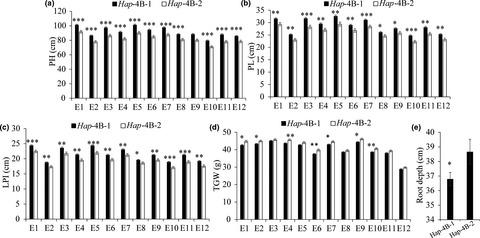当前位置:
X-MOL 学术
›
Food Energy Secur.
›
论文详情
Our official English website, www.x-mol.net, welcomes your
feedback! (Note: you will need to create a separate account there.)
TaERF73 is associated with root depth, thousand-grain weight and plant height in wheat over a range of environmental conditions
Food and Energy Security ( IF 4.0 ) Pub Date : 2021-09-10 , DOI: 10.1002/fes3.325 Yan Du 1, 2 , Chaonan Li 2 , Xinguo Mao 2 , Jingyi Wang 2 , Long Li 2 , Jinwen Yang 1 , Mengjia Zhuang 2 , Daizhen Sun 1 , Ruilian Jing 2
Food and Energy Security ( IF 4.0 ) Pub Date : 2021-09-10 , DOI: 10.1002/fes3.325 Yan Du 1, 2 , Chaonan Li 2 , Xinguo Mao 2 , Jingyi Wang 2 , Long Li 2 , Jinwen Yang 1 , Mengjia Zhuang 2 , Daizhen Sun 1 , Ruilian Jing 2
Affiliation

|
AP2/ERF is a plant-specific transcription factor superfamily regulating plant growth, development and responses to multiple stresses. However, the roles of ERF genes in the growth and development of wheat (Triticum aestivum L.) remain elusive. In this study, a novel ERF gene TaERF73 was cloned from wheat. qRT-PCR analysis showed that TaERF73 is predominantly expressed in roots. It responds to treatments of auxin, MeJA, ABA, low temperature and drought stresses. Ectopic expression of TaERF73 in rice caused short root length, indicating that TaERF73 is a negative regulator of root growth. Four SNPs were detected in TaERF73-4B coding region through sequence polymorphism analysis. A dCAPS (derived cleaved amplified polymorphic sequence) molecular marker was developed based on the SNP at 119 bp (G/C) of TaERF73-4B. Association analysis between genotypes and agronomic traits revealed that Hap-4B-2 is a haplotype of TaERF73-4B associated with shorter plant height, higher thousand-grain weight and longer root depth. The distributions of haplotypes in ten Chinese major wheat zones suggested that Hap-4B-2 has been positively selected in the breeding process. Together, the ERF gene TaERF73 is associated with root depth, plant height and thousand-grain weight under drought, heat and well-watered conditions. The molecular marker developed in this study could be a valuable source for marker-assisted selection and genetic improvement in wheat.
更新日期:2021-09-10









































 京公网安备 11010802027423号
京公网安备 11010802027423号